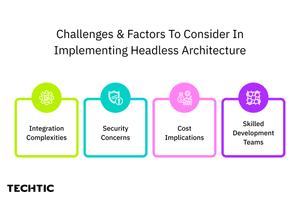What is Headless Commerce? – Here is Everything You Want to Know
Sector: Digital Commerce
Author: Nisarg Mehta
Date Published: 05/21/2024

Contents
- Understanding Headless Commerce
- Benefits of Headless Commerce
- How Headless Commerce Works
- Front-End and Back-End Technologies Examples
- The Important Features of Headless Commerce
- Headless Commerce Use Cases
- Challenges and Considerations in Implementing Headless Architecture
- Popular Platforms and Technologies for Headless Commerce
- Quick Glance On How to Implement Headless Commerce
- Final Words
Headless commerce is an innovative technology of eCommerce that disjoins the presentation layer from the back-end functionality. This (assumed) division permits companies to tailor the online store’s user interface while maintaining the proper efficiency on the back end.
In the context of 2024 headless commerce is a service providing companies and consumers with faster and more intuitive shopping experiences. Today, 80% of businesses that don’t have headless architecture say that they plan to implement it in the next two years.
An increasing part of businesses motivation arises from being agile, customizable and catering to special market shopping tastes.
The headless commerce approach provides the users with many such benefits as higher speed level, better performance, enhanced user experience and the possibility of multichannel presentation. These positive sides place it in a strong position among the companies that aim to stay on top in the ever changing market of eCommerce. Let’s get closer to the discussion on what headless commerce is and why it is becoming the favorite way for online retailers.
Understanding Headless Commerce
Headless commerce stands for separating the front end (the “head”) of an eCommerce system from the back end (the “body”). With this isolation, each layer works individually, granting more control to the businesses over user experience and functionality.
What is Headless Commerce?

Traditionally, in eCommerce, the front end and back end are combined closely. This monolithic structure is not agile and cannot be scaled. While headless commerce separates these components, it provides an opportunity for developers to alter either the front or back end by updating or changing the front without affecting the back.
Comparison with Traditional Commerce
Traditional venture commerce systems involve one package: the front end and the back end, where they are closely integrated. This could result in longer development cycles, slower updates and prove to be a challenge in scaling.The Headless commerce decouples these layers, which provides more flexibility and speedy innovation.
For instance, headless commerce provides an option of upgrading the front end without changing the core system, consequently, speeding up the process.
Main Components of a Headless Commerce System
- Content Management System (CMS): Manages the content that is visible on the front end.
- Front-End Framework: Examples of such tools are React, Angular, or Vue. JS is used to build user interfaces.
- Back-End Commerce Engine: Covers key business functions such as product management, orders, and customer data.
- APIs: Bind the front end and back end making it possible to carry out communication between the two layers.
Headless commerce allows companies to pick the most appropriate tools and technologies for the given task, making the eCommerce solution more customized and efficient. This is why the headless commerce system is the trend of the businesses that want to improve their online presence.
Benefits of Headless Commerce
Decapitated commerce has plenty of benefits which make it a considerable option for modern eCommerce businesses. Here are the most enjoyable ones:Bl

Flexibility and Customization
Headless commerce enables enterprises to provide customers with personalized and unique user experiences. Companies can leverage the best technologies for each layer by “decoupling” the front end from the back end. Thus, you could use a modern front-end framework like React or Vue.js together with a strong back-end system such as Magento or Shopify Plus.
Enhanced User Experience
A quicker, more agile website caters for the customers’ experience. With headless commerce, the front end can be developed separately from the back end, thus achieving fast loading speeds and easier interactions. This generates a more active and meaningful shopping experience that increases customer return and maintenance.
Improved Performance and Scalability
Decoupling the front end and the back end grants more scalability and better performance management. Businesses can scale each layer separately by making the system accommodate more traffic and transactions during peak hours without compromising performance.
Omnichannel Capabilities
Heads commerce facilitates similar and synchronized user experience either on the web, mobile, social media, and so on. The flexibility guarantees that customers have a seamless experience when using different platforms of brand interaction.
These benefits allow businesses to stay adaptable, satisfy customers, and continue to be competitive along the rapidly changing digital landscape.
How Headless Commerce Works
Headless commerce divides the front-end presentation layer from the back-end commerce functionality layer. This separation is achieved by means of APIs that help in communication between the two layers.
Separating the Front-End from the Back-End
With headless commerce, the front-end (such as an ecommerce website or mobile app) can be detached from the back-end (which includes product management, order processing and customer data). This separation allows developers to update or redesign the front end without having to alter the back end, and vice versa. For example, one can make the website interface friendlier to the user without changing the commerce rules that govern the website.
APIs for Communication
Headless commerce heavily relies on APIs (Application Programming Interfaces). They act as a middle layer between the front-end and back-end, providing seamless communication and data sharing. APIs provide the interface between the front end and the back end, allowing the user to check out product information, customer data, or order statuses. The API-driven approach guarantees that the client-side remains fast, responsive, and capable of handling real-time updates.
Front-End and Back-End Technologies Examples
- Front-End Technologies: Some of the popular frameworks used for creating the front end in a headless commerce system include React, Angular, and Vue.js. These templates facilitate the development of dynamic and interactive-user interfaces which intensify the public shopping experience.
- Back-End Technologies: The back office can be driven by market leading eCommerce platforms like Magento, Shopify Plus, and Salesforce Commerce Cloud. These platforms are responsible for vital business operations which include stock management, payment processing, and customer relationship management.
Through the interface between decoupled front-end and back-end and via APIs for smooth communication, headless commerce offers companies the possibility to innovate and change with the demand fluctuations of the market.
The Important Features of Headless Commerce
The headless commerce has specific features that set it apart from the traditional eCommerce systems. Such elements lay the groundwork for the versatility, scalability and efficiency that characterize headless commerce.
API-First Architecture
In a headless commerce setup, APIs provide the foundation for the system’s architecture. APIs facilitate easy and smooth exchange of data among front and back end applications. Such an API-first approach guarantees that the front end can draw the data or functionality from the back end without having any close connection to it. Thus, businesses can effortlessly combine the necessary features and services.
Microservices-Based Approach
Headless commerce tends to use a microservices architecture approach in which the back end is divided into small, modular services that can be developed, deployed, and scaled individually. The microservice is responsible for carrying out a certain function, for example, inventory management, payment processing, or customer authentication. This modularity attributes to the system’s flexibility and scalability, which make its update and maintenance convenient.
Cloud-Native Infrastructure
Employing cloud-native technologies is another distinctive feature of headless commerce. Cloud-native architecture enables the system to be scalable, reliable, and deal with the fluctuations in various ways. It not only allows businesses to exploit the leading edge of cloud computing innovations like serverless architectures and containerization, but it also makes the performance better and less operational costs.
The State of Commerce report by Salesforce reports that 77% of businesses using headless architecture declare that it boosts their agility and helps them implement changes on the storefront faster.
Together, these functions provide headless commerce with the flexibility, responsiveness, as well as the customization that are needed by businesses to stay in pace with the fast changing market.
Headless Commerce Use Cases
Headless commerce is versatile and can be employed in different industries and models of business.
Retail and eCommerce
Retailers can use headless commerce to design personalized and interactive shopping experiences. Disassociating the front and back end allows them to easily respond to shifting consumer choices and trends. For instance, a fashion retailer can update product design, promo, or other content without affecting the core eCommerce functionality of the site.
B2B Commerce
In B2B eCommerce, businesses commonly have very specific needs for their online platforms, such as custom pricing, bulk ordering, and detailed product information. Headless commerce provides a platform for B2B companies to be flexible in designing solutions that meet their business’ unique requirements. For example, a company may choose to create a personalized ordering portal for each of their clientele, thereby improving the end user’s experience and simplifying the purchase process.
Digital Marketplaces
Digital marketplaces with multiple vendors can use headless commerce through offering their clients a consistent and smooth experience across all vendors. The marketplace operators can detach the front end and back end in this way that makes every vendor’s storefront adjustable while keeping the entire platform unified.
Content-Driven Commerce
Publishers and media companies can incorporate commerce functionalities into their content platforms by using headless commerce. Such a strategy makes it possible to get the most out of the content while at the same time giving the user an easy to use environment. In particular, a news webpage can integrate a marketplace that merchandises comparable items or subscribes without distracting the reader while reading.
Challenges and Considerations in Implementing Headless Architecture
However, the benefits of headless commerce comes along with their own set of solvable challenges:

Integration Complexities
The primary difficulty which occurs in headless commerce is the integration of different systems and the maintenance of smooth communication channels among them. Because the communication between the front end and the back end is relying on APIs so much, they are decoupled heavily. This means that without a good API management and monitoring in place, it can lead to data synchronization problems or availability issues.
Security Concerns
Given that there are so many components that communicate via APIs, security is an important element. Making sure that data is being protected and communication between the front end and back end is taken care of at all times is mandatory. Businesses are required to employ strong authentication, encryption and other security measures to keep secret information intact.
Cost Implications
The initial costs for setting up and maintaining a headless commerce architecture is higher compared to conventional eCommerce infrastructure. The costs could incur front-end interfaces development, managing multiple integrations and keeping healthy back-end structures. Nevertheless, these costs are counterbalanced by the long-term advantages in terms of flexibility and scalability.
Need to Create Skilled Development Teams
It is essential to have staff members who have knowledge and experience in diverse technology and development practices when implementing and running a headless commerce system. Developers should have mastered front-end frameworks, back-end systems and API management. On the other hand, some businesses find this expertise requirement problematic by having to incur additional training costs of hiring.
In such cases, hiring an eCommerce development company that excels in building headless commerce architecture as well as building the entire front and back end is the best option to consider. Their experts know the intricacies of headless architecture and can implement it the right way for future robustness and relevancy.
Popular Platforms and Technologies for Headless Commerce
Headless commerce has a number of leading platforms and technologies which provide various feature sets and functionality.
Magento
Magento offers the flexibility and scalability necessary to support headless commerce. It provides rich API solutions which enable companies to design custom front-end UI and simultaneously take advantage of Magento backend functionalities. Magento’s open source system is the one preferred by business owners who wish to adapt their eCommerce platforms to specific business needs.
Shopify Plus
Shopify Plus is the high volume business version of Shopify. It provides for headless commerce through its vast APIs, therefore businesses can engineer distinct front – end designs while maintaining a resilient and reliable system. Shopify Plus enjoys a high amount of user-friendliness and speedy setup which makes it a great choice for businesses that don’t want to allocate a lot of development resources into introducing headless commerce.
Salesforce Commerce Cloud
Salesforce Commerce Cloud covers the whole suite of tools to create a headless commerce system. Its API-first approach and cloud-native base make it a nice platform for producing scalable and flexible eCommerce encounters. Salesforce Commerce Cloud also combines perfectly with other Salesforce products, covering the task of building customer relationships and marketing operations from a single platform.
Other Notable Platforms
- BigCommerce: BigCommerce, known for its dynamic API performance and scalable architecture, is a preferred option for businesses planning to switch to headless commerce.
- Contentful: A Headless CMS that connects well with Headless Commerce frameworks thus enabling businesses to manage and deploy content across channels without difficulty.
- Commercetools: Highly flexible platform with microservices architecture and vast API support which were designed specifically for headless commerce.
Quick Glance On How to Implement Headless Commerce
Evaluate Current Infrastructure:
- Examine the existing structure of your eCommerce and find the parts that need to be optimized.
- Decide whether a headless architecture can be supported by your current back-end system.
Select the Right Technologies and Plan:
- Select a front-end framework based on your company’s needs. g. either, React, Angular, or Vue.js).
- Pick a potentially strong back-end platform that can be used in headless commerce.
- Create a detailed migration plan that maps out all steps required to move to a headless configuration.
- Include timelines, resources allocation and risk management plans.
Develop the Front End:
- Create a new front end with the chosen framework.
- Make sure that the design is user-friendly and improves the customer experience.
Integrate via APIs:
- Use APIs to integrate the new front end to the existing back-end system.
- Establish efficient communication and data sharing between the two layers.
Test and Deploy:
- Conduct comprehensive testing to identify and repair any errors.
- Carry out performance, security and user experience tests to confirm that everything works the way it should.
- Commence with a trial project to monitor the new setup on a smaller scale.
- Start with rolling out headless commerce systems to the whole platform in phases.
Monitor and Optimize:
- Keep monitoring the system’s performance and user feedback on a constant basis.
- Make necessary changes for an increased functionality and better user experience.
Best Practices for Implementation
- Start Small: First, set up a pilot project for testing and refinement before the company-wide rollout.
- Involve Stakeholders: Involve all stakeholders such as developers, marketers, and customer service units to be able to make the transition easier.
- Ensure Compatibility: Ensure that all components like CMS, front-end framework and back-end system are compatible and effortlessly synchronize together.
Final Words
Year 2024 expects to see an increase in headless commerce adoption due to the necessity of agility and individualized experience shopping. Amazon and Nike are among businesses that have demonstrated the value of this approach already by making sales rise due to better customer engagement and improved conversion rates.
Moving forward, the use of AI, voice commerce, AR/VR, the move to mobile, and the emphasis on sustainability will keep shaping the headless commerce landscape. Being updated on these trends will help businesses offer a modern, interactive, and responsive shopping experience.
If you want to implement headless architecture to your eCommerce storefront, feel free to reach out to our eCommerce technology experts. They’ll certainly help you.
Latest Tech Insights!
Join our newsletter for the latest updates, tips, and trends.







